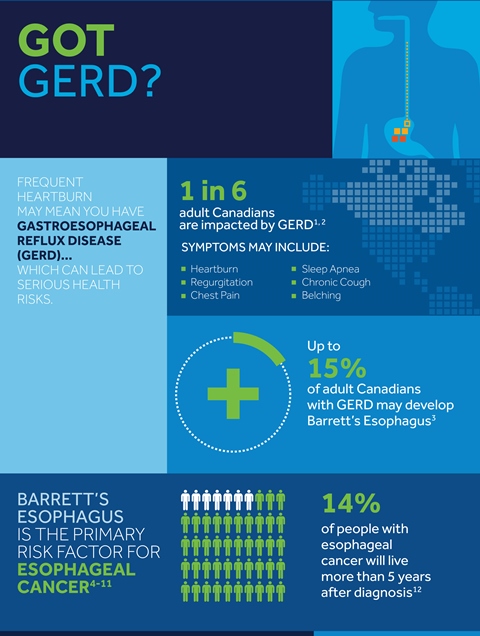By Melicent Lavers-Sailly
For Mary Hedley-Brown, the news came as a shock. A survivor of cervical cancer, she had lost her husband to cancer as well as a friend who died from esophageal cancer. It was frightening for her to get a similar diagnosis.
“Ever since I was a teenager I’ve had terrible heartburn and acid reflux, but it never occurred to me that it could cause cancer in your esophagus,” she says.
Acid reflux can be a sign of gastroesophageal reflux disease (GERD), which affects one in six adult Canadians. Symptoms may include heartburn, regurgitation, chest pain, sleep apnea, chronic cough or belching. Up to 15 per cent of adult Canadians with GERD may develop Barrett’s esophagus, a condition in which cells in the lining of the esophagus become abnormal after being exposed to stomach acid over an extended period of time.
These abnormal cells are the primary risk factor for esophageal cancer, a deadly form of the disease. Approximately 86 per cent of people with esophageal cancer will die within five years of diagnosis.
Patients with Barrett’s esophagus are routinely monitored to watch for progression to high-grade dysplasia, which is the critical step towards the development of cancer. Until recently, the only reliable treatment at this point was an esophagectomy, or surgical removal of part or all of the esophagus.
Now, however, a new and minimally invasive technology known as radiofrequency ablation (RFA) is becoming available in Canadian hospitals, giving patients such as Mary a far more positive prognosis.
“When I was diagnosed with Barrett’s esophagus,” she recalls, “my family doctor would bring me in every three to six months to check it, and then when it became high-dysplasia, he referred me to Dr. Dhaliwal.”
Dr. Harry Dhaliwal is a therapeutic gastroenterologist at The Ottawa Hospital, which recently acquired an RFA system called BarrxTM.
“When I did the initial diagnostic endoscopy to evaluate the Barrett’s mucosa, Mary had two nodules within that area,” he says. “When those nodules were removed, they both contained cancer. With RFA and ablative therapy, we’re able to treat patients early. This prevents the progression to high-grade dysplasia, which was previously treated with esophagectomy.”
RFA technology uses current to create heat that eradicates tissues affected by Barrett’s esophagus. With the patient under sedation, the physician inserts a catheter into the esophagus. The catheter carries an inflatable balloon containing bands that emit radio waves with great precision. When the balloon is inflated, the physician delivers a burst of energy that ablates, or destroys, the abnormal cells. The body will later replace these cells with healthy ones.
“RFA is a proven technology for treating Barrett’s mucosa,” says Dr. Dhaliwal. “It’s very tolerable and there’s a very durable response.” Indeed, RFA technology has been shown to be 98.4 per cent effective at eliminating dysplastic Barrett’s esophagus tissue.
The outcome for Mary could not have been better. A follow-up endoscopy showed that the RFA procedure was a complete success. Since then she feels great, has got married and is starting a new life.
“I really feel that a patient should be their own best friend,” she says now. “Anybody who has a history like I had should get checked.”
However, Dr. Dhaliwal warns, “One of the difficulties in identifying patients with Barrett’s esophagus is that there’s a large percentage who don’t actually experience symptoms of acid reflux. They may have undiagnosed Barrett’s esophagus that we may not be aware of. We often miss those patients, so part of the struggle for us as physicians is being able to screen patients properly and selectively.”
At present there’s no consistent screening protocol for high-risk patients similar to the program for colon cancer, and healthcare resources for endoscopies are limited.
“Patients who do have risk factors and symptoms of reflux for an extended period of time should be getting surveyed,” Dr. Dhaliwal says. “Even younger patients who have a longstanding history of reflux and have Barrett’s mucosa, if there’s a family history of esophageal cancer or there’s a large segment of Barrett’s, should be considered for ablative therapy.”
“It’s important to be your own advocate,” Mary adds. “Anyone who has acid reflux should be aware that it could lead to Barrett’s esophagus. If you’ve had GERD for a long time, talk to your doctor. I was just lucky.”
Melicent Lavers-Sailly is senior manager of communications and corporate marketing at Medtronic Canada.


